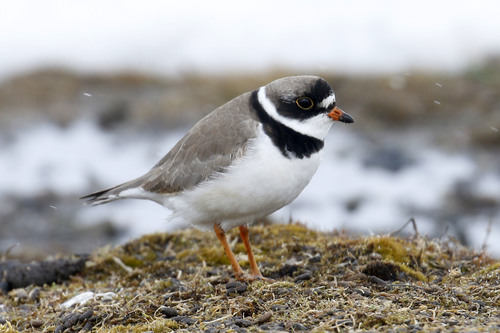
Semipalmated Plover
The Semipalmated Plover (*Charadrius semipalmatus*) is a small, migratory shorebird known for its distinctive dark breast band and partially webbed feet, which give it its name. It plays a vital role in coastal and wetland ecosystems, primarily as a consumer of small invertebrates. While not holding significant cultural importance in many regions, it is a cherished sight for birdwatchers along its migratory routes and breeding grounds. Its presence often indicates a healthy, functioning intertidal habitat.
17-19 cm
Length
35-37 cm
Wingspan
Least Concern
Conservation Status
Distribution
Breeds in the Arctic and subarctic regions of North America, from Alaska to Newfoundland. Migrates south to winter along the coasts of the southern United States, Central America, the Caribbean, and South America, as far south as Chile and Argentina. Altitudinal range is generally low, near sea level.
Lifespan
Up to 10 years in the wild, though average lifespan is likely shorter.
Semipalmated Plover's Habitat
Habitat Types
Coastal beaches, Mudflats, Salt marshes, Tundra (during breeding season), Riverbanks and lakeshores (during migration)
Climate Zones
Arctic, Subarctic, Temperate, Tropical
Adaptations
Their partially webbed feet (hence 'semipalmated') help them walk on soft mud and sand. Their relatively short bills are well-suited for picking small prey from the surface.
Variations
No recognized subspecies, but slight variations in size and plumage darkness may occur across its broad range.
Appearance
Breeding Plumage
Breeding plumage features a distinct black breast band, a white forehead, and a bright orange bill with a black tip. Non-breeding plumage is duller, with a browner breast band and a duller bill.
Seasonal Feather Changes
Plumage changes between distinct breeding and non-breeding seasons, with the breeding season exhibiting more vibrant colors and patterns.
Sex Based Plumage Differences
Males and females have similar plumage, though males may have slightly more defined markings during breeding season.
Notable Features
Single black breast band (distinguishing it from the similar Piping Plover), Partially webbed feet, Orange legs (yellowish in non-breeding plumage), White forehead and throat
Diet and Feeding
Primary Foods
Small invertebrates, Crustaceans, Mollusks, Marine worms, Insects (especially during breeding season)
Foraging Behavior
Uses a 'run-stop-peck' foraging style, running short distances, pausing to scan for prey, and then pecking at the surface. Often forages along the water's edge.
Specializations
Their short bill is adapted for picking small prey items from the surface or just below the surface of mud or sand.
Seasonal Diet Variations
Diet shifts slightly depending on location and season. During breeding season, they consume more insects, while coastal wintering birds rely more on marine invertebrates.
Behavior
Social Structure
Generally found in small flocks during migration and winter. During breeding season, they are territorial.
Communication
A clear, two-note 'chu-wee' call, Soft, piping notes during courtship, Alarm calls when threatened
Migration
Long-distance migrant. Travels in flocks, often following coastlines. Some individuals may travel thousands of kilometers between breeding and wintering grounds.
Territorial or Group Behaviors
Defends small nesting territories during breeding season. Forms loose flocks during migration and on wintering grounds, often associating with other shorebird species.
Conservation
Threats
Habitat loss and degradation (coastal development, pollution), Disturbance at breeding and wintering sites (human activity, dogs), Climate change (sea-level rise, changing prey availability), Predation (by gulls, raptors, and mammals)
Protection Programs
Migratory Bird Treaty Act (US and Canada), Western Hemisphere Shorebird Reserve Network (WHSRN), Various local and regional conservation initiatives
Local National Laws
Protected under various national and international laws, including the Migratory Bird Treaty Act in the United States and Canada.
Population Trend
Stable
Population Estimates
Estimated global population of around 150,000 individuals.
Interesting Facts
They are named for their partially webbed feet.
The 'semi' in semipalmated refers to the partial webbing between their toes, an adaptation for walking on soft substrates.
They can undertake impressive migrations.
Some individuals travel over 6,000 kilometers (3,700 miles) between their breeding and wintering grounds.
They are highly adaptable to different coastal habitats.
They can be found on sandy beaches, rocky shores, and muddy estuaries, showcasing their versatility.
Faqs about Semipalmated Plover
How can I distinguish a Semipalmated Plover from other similar plovers?
Look for the single, complete black breast band, orange legs, and orange bill with a black tip during breeding season. In non-breeding plumage, the breast band is browner, but still usually complete.
Where is the best place to see Semipalmated Plovers?
During migration, they can be seen along coastlines throughout North and South America. During the breeding season, look for them in the Arctic and subarctic tundra.
Are Semipalmated Plovers endangered?
No, they are currently listed as Least Concern by the IUCN. However, they face threats from habitat loss and climate change, so their populations should be monitored.
Copyright @ Nature Style Limited. All Rights Reserved.
 English
English